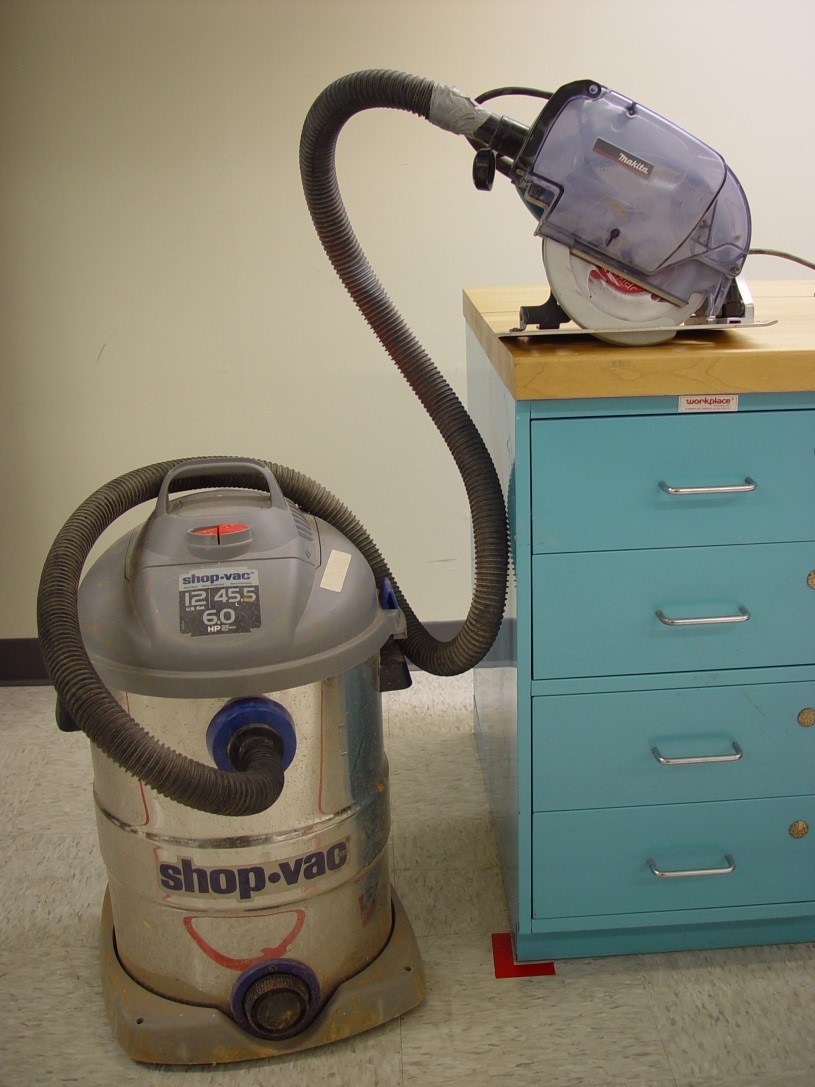Engineering Controls Database
Cutting fiber-cement siding with power saws, crystalline silica exposure
| Fiber-cement siding, a construction material that has grown in popularity in recent years, contains crystalline silica and when cut with power saws, can create fine dust particles that a worker can inhale. One study by Lofgren et al. [2004] reported that cutters’ uncontrolled exposures to respirable crystalline silica can be up to 3.4 times the NIOSH recommended exposure limit (REL) for respirable crystalline silica of 0.05 mg/m3. In an in-depth field survey, Qi et al. [2013] also reported that a cutter’s uncontrolled exposure to respirable crystalline silica resulted in an exposure up to 2.6 times the NIOSH REL. In May 2016, OSHA published a new permissible exposure limit (PEL) of 0.05 mg/m3 as an 8-hr time weighted average (TWA) for respirable crystalline silica [81 Fed. Reg. 16285, 2016], making it critical to address these overexposures. | |
|
Breathing dust that contains respirable crystalline silica can lead to silicosis, a deadly lung disease. No effective treatment exists for silicosis, but it can be prevented by controlling workers’ exposures to dust containing respirable crystalline silica. Exposure to respirable crystalline silica has also been linked to lung cancer, kidney disease, reduced lung function, and other disorders [NIOSH 2002]. NIOSH conducted a research study that led to a Workplace Solution Document [NIOSH 2015] for the construction industry. In a laboratory setting, researchers established a method for testing the generation rate of dust from different tools [Qi et al., 2016a, 2016b], and looked at three dust-collecting circular saws connected to an external vacuum. Findings indicated that the circular saws, used in conjunction with an external vacuum cleaner that had a cyclone pre-separator and a high-efficiency particulate air (HEPA) filter cartridge, removed at least 81% of the hazardous dust even with an air flow rate lower than that found in a typical shop vacuum. |
|
|
NIOSH’s recommendations to control silica-containing dust when cutting fiber-cement siding with circular saws include: •Use a shop vacuum with an air-flow rate of 30 Cubic Feet per Minute (CFM) or higher with a hose connected to the circular saw. •The hose used to connect the shop vacuum and circular saw should be 1.25 inches or greater in diameter and should be only as long as necessary and be kept straight. •A high efficiency disposable filter bag can be used as a pre-filter in the shop vacuum to capture most of the dust. •The shop vacuum and circular saw can be plugged into an intelligent vacuum switch, which turns on and off the vacuum and ensures the vacuum is running while operating the saw, avoiding uncontrolled dust release. For shop vacuums that don’t have the switch incorporated in it, an aftermarket device with the same feature can be purchased and used. •Use only circular saws with a built-in dust collection container or shroud that functions as a hood, partially encloses the saw blade, and can easily connect to a shop vacuum. •Use polycrystalline diamond-tipped (PCD) blades designed for cutting fiber-cement siding.   |
|
| 358-11A; 358-12A; 358-13A; 358-14A; 358-15A; 358-16A; | |
|
81 Fed. Reg. 16285 [2016]. Occupational Safety and Health Administration: occupational exposure to respirable crystalline silica, final rule. https://www.federalregister.gov/articles/2016/03/25/2016-04800/occupational-exposure-to-respirable-crystalline-silica Lofgren DJ, Johnson DC, Walley TL [2004]. OSHA Compliance issues: silica and noise exposure during installation of fiber-cement siding. Occup & Env Hyg J 1:D1-D6. NIOSH [2002]. NIOSH Hazard Review: Health effects of occupational exposure to respirable crystalline silica. Cincinnati, OH: U.S. Department of Health and Human Services, Centers for Disease Control and Prevention, National Institute for Occupational Safety and Health, DHHS (NIOSH) Publication No. 2002–129. NIOSH [2015]. Workplace Solutions: Reducing Hazardous Dust Exposure When Cutting Fiber-Cement Siding. Cincinnati, OH: U.S. Department of Health and Human Services, Centers for Disease Control and Prevention, National Institute for Occupational Safety and Health. DHHS (NIOSH) Publication No. 2015-185, pp. 1-4, NIOSHTIC # 20046308. http://www.cdc.gov/niosh/docs/wp-solutions/2015-185/. Qi C, Echt A, See M [2013]. In-Depth Survey Report: partnering to control dust from fiber-cement siding. DHHS (NIOSH) Report No. EPHB 358–11a. http://www.cdc.gov/niosh/surveyreports/pdfs/358-11a.pdf Qi C, Echt A, Gressel M [2016a]. The generation rate of respirable dust from cutting fiber cement siding using different tools. Annals of Occupational Hygiene. Accepted for publication as of October 5th, 2016. Qi C, Echt A, Gressel M [2016b]. On the characterization of the generation rate and size-dependent crystalline silica content of the dust from cutting fiber cement siding. Annals of Occupational Hygiene. 60(2), 220-230. |
|
| 238170 | |
|
construction engineering control Fiber-cement siding Power Saws respirable crystalline silica respirable dust |
|
| To validate the effectiveness of a regular shop vacuum at reducing dust, researchers conducted further studies at construction sites where workers were cutting fiber-cement siding. Results of the field studies showed that a regular shop vacuum controlled the amount of silica-containing dust in the air to well below the NIOSH REL for crystalline silica. |
